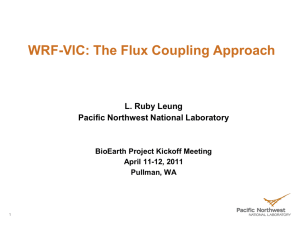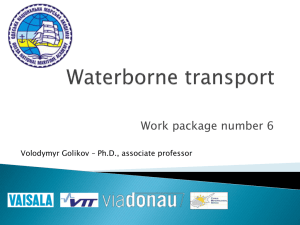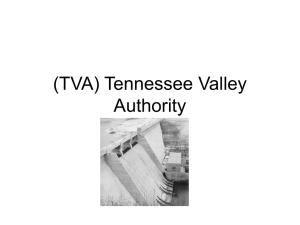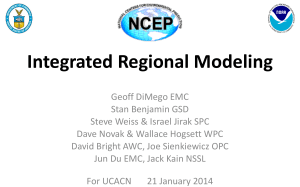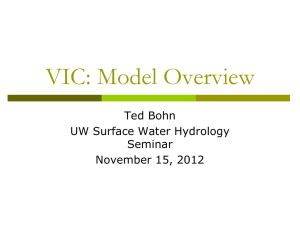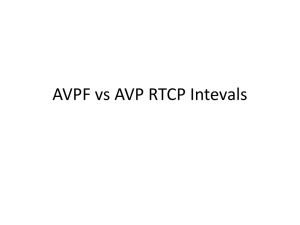Global Evaluation of MTCLIM
advertisement
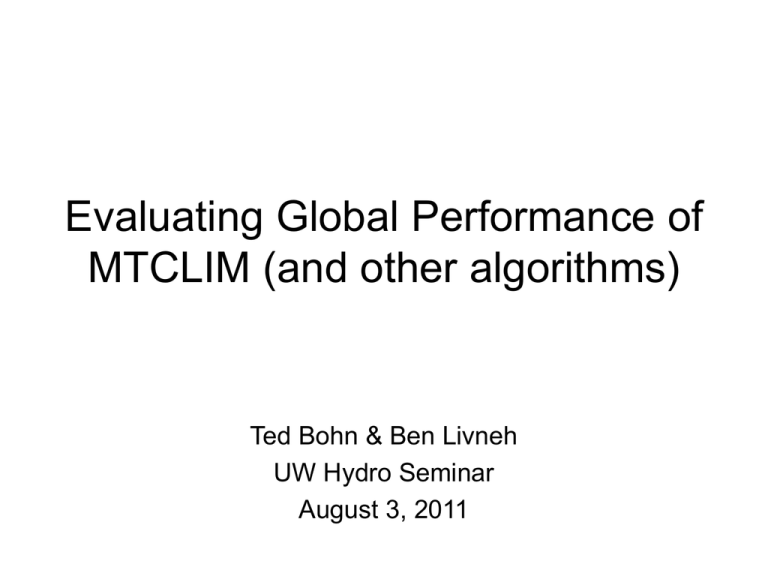
Evaluating Global Performance of MTCLIM (and other algorithms) Ted Bohn & Ben Livneh UW Hydro Seminar August 3, 2011 Motivation Large-scale hydro/ecological models need accurate radiation & humidity inputs • Reanalysis products aren’t generally available in near-real-time or at resolution we desire • Most met stations record only Daily P, Wind, Tmax, Tmin • Fortunately algorithms exist to convert Daily Tmax/Tmin to Humidity, SW, and LW Forcing Algorithms and VIC • VIC uses MTCLIM algorithm to get daily SW and VP (and cloudiness) – from University of Montana (also used in UM’s BIOME-BGC model) – Original version (in VIC) is 4.2 – Version 4.3 released in 2001 – not in VIC – Should we upgrade VIC’s MTCLIM to 4.3? • MTCLIM SW depends on local slope, aspect, horizon angles – Large-scale models like VIC don’t have a good way of representing these over large grid cells – VIC sets these to 0 – Is this biasing our results? Forcing Algorithms and VIC • VIC uses TVA algorithm to get LW – Depends on T, cloudiness, and VP – Cloudiness and VP come from MTCLIM • Diurnal cycles: – VIC also uses spline to interpolate between Tmin and Tmax for hourly T • Accuracy? – Other hourly variables (SW, VP, LW) derived from daily quantities and hourly T Not Fully Tested • Original MTCLIM algorithms were only tested against observations in continental US – (Kimball et al 1997; Thornton and Running 1999) • Shi et al (2010) evaluated MTCLIM SW on monthly basis for pan-Arctic • MTCLIM 4.3 contains updates: – SW correction for snow albedo effect – VP correction for better performance in humid climates – These updates were only partially tested in Austrian alps (Thornton et al 2000) • Performance of 4.2 and 4.3 SW and VP, and resulting TVA LW, not fully explored across full range of global climates Opportunity to Test • BSRN network – Hourly radiation, humidity, and temperature observations – Global coverage – Stations range up to 18 years of data Questions 1. How do the original MTCLIM algorithms perform vs. BSRN observations across the full range of global climates? 2. What effects do the MTCLIM 4.3 updates have on results, across the globe? 3. How does using 0 for slope, horizon affect MTCLIM 4.2 and 4.3? 4. How does the TVA LW algorithm perform globally (esp. when linked to MTCLIM)? 5. How does VIC’s spline interpolation to hourly perform, globally? Methods: MTCLIM SW SW at ground SW before any atm. absorption Total daily clear-sky trans. (effect of optical mass) Total daily cloud trans. Rgh Rpot Tt ,max T f ,max Rpot = sum of direct and diffuse components •Direct depends on local slope, aspect •Diffuse depends on local horizon •VIC sets slope, aspect, and horizon to 0… Hourly Rpot, Sunrise to sunset Tt ,max Clear-sky trans. As f’n of solar angle ss Pz / P0 m R pot ,s 0,nadir ,dry s sr (Thornton and Running, 1999) Humidity Effect R pot ,s VP s sr ss NOTE: we need VP observations to estimate SW Methods: MTCLIM SW Daily T Range (DTR) Cloud Trans. Tf ,max 1.0 0.9 exp B T C 30-Day Average Daily T Range (DTR) B bo b1 exp b2 T Tfmax has large daily variability, and influences both SW and LW (and VP indirectly) Methods: MTCLIM SW 4.3 SWE correction (Thornton et al, 2000) •Account for extra reflections of SW off snow pack •Effect consists of a flat-ground component plus reflections off hill slopes (which depend on local horizon angle) •Essentially proportional to SWE up to 300mm •MTCLIM uses degree-day snow model to compute daily SWE •Tested in Austrian Alps but not globally Methods: MTCLIM VP First approximation: dewpoint temperature Tdew = Tmin Kimball et al. (1997): Tdew Tmin 0.127 1.1211.003 1.444EF 12.312EF 2 32.766EF 3 0.0006T where ΔT = daily temperature range EF E p,day w t day Pann,eff Water density Effective annual precip from 90-day window centered around current day Daylength (seconds) Potential evap from Priestly-Taylor (1972) E p,day Rn G = 1.26 Net SW assuming albedo of 0.2 Ground flux assumed 0 Finally, compute VP as saturation vapor pressure at T = Tdew Tetens (1930) 17.27 T es 0.6108exp 237.3 T Methods: MTCLIM VP Recall that SW depends on VP estimate (through Ttmax eqn). But VP depends on SW estimate (through Priestly-Taylor) – need to iterate Iteration: 1. Assume Tdew = Tmin, constant over day 2. Compute VP from Tdew, compute Ttmax and SW 3. Use SW to compute more sophisticated VP 4. Update SW from updated VP 4.3 VP correction (Thornton et al, 2000): for stations with annual Epot/P ratio < 2.5, don’t iterate Methods: TVA LW KEaT 4 where 2 K 1 0.17t skc (TVA, 1972) Cloud fraction, either from observations or from MTCLIM 2 t skc 1 T f ,max 0.65 (MTCLIM) Tfmax from MTCLIM SW estimate Ea 0.740 0.0049 VP MTCLIM VP estimate Methods: Summary • • • • • • SW depends primarily on daily T range SW also depends on local topography VP depends on Tmin and Epot/Prcp ratio SW and VP depend on each other as well LW depends primarily on T4 LW also depends on daily T range and VP Methods: Hourly • Air Temperature: – Assume Tmin occurs at sunrise, Tmax occurs in mid-afternoon – Interpolate to hourly T via spline • Vapor Pressure: – Assume constant over entire day • Vapor Pressure Deficit: – = svp(Tair(hour)) – VP(day) • SW: – Compute hourly solar angle, scale daily total between sunrise and sunset by MTCLIM daily SW • LW: – Apply TVA algorithm using Tair(hour), VP(day), Tskc(day) Methods: BSRN • Station selection – record length >= 5 y and met variables available within 20 km Methods: BSRN • BSRN doesn’t record precip; some stns don’t record T or VP either • Took prcp and whatever other vars were needed from the nearest GSOD met station • Filled gaps by repeating last good value (or 0 in case of prcp) Methods: Simulations • Ran VIC/MTCLIM at hourly time step • Gap-filled days nulled out of VIC results • Aggregated to daily, monthly, computed monthly averages Results: SW, 4.2 • Strong negative bias for monthly average DTR <6C Results: SW, 4.2 • Almost all low DTR cases occur at maritime sites (within 5 km of ocean) Maritime Continental • Can be traced to bias in Tfmax (cloud effect) • Appears that ocean’s moderating influence causes lower DTR even on clear days – MTCLIM is fooled into thinking it’s cloudy All Maritime Continental • Maritime sites showed up as outliers in the original Thornton and Running (1999) paper Optimal B higher than curve → simulated B (and Tfmax) will be too low T & R thought that seasonality of precip had something to do with it. Note: some maritime sites (Eugene, Portland) had optimal B lower than curve → simulated B (and Tfmax) will be too high • Maritime sites are a large portion of our data set • SW biases may affect the other variables • To allow us to use data from these sites, applied a simple linear bias correction for DTR < 5.7 C • Now, SW data are relatively unbiased globally • Does this have much effect on VP or LW? – Turns out, not really – wait to see maritime VP and LW plots… (bias-corrected) Note: we don’t claim that this is a fix to the MTCLIM algorithm; we are only doing this to clean up the data MTCLIM 4.3 SW snow correction • Select only days when MTCLIM snow model believed snow was present All Maritime Continental MTCLIM 4.2 VP, and 4.3 VP correction • • • • 4.2 VP relatively unbiased 4.3 VP tends to make things worse Individual months from each station may be more humid or arid than the station’s annual average Would monthly aridity criterion help? Probably not… All Arid (annual aridity > 2.5) aridity aridity •Aridity = Epot/Pannual •lnpp = ln(aridity) for the given month •For aridity = 2.5 (threshold), lnpp = 0.9 Humid (annual aridity < 2.5 MTCLIM 4.2 VP, and 4.3 VP correction • Maritime stations introduce weird trend… • Bias-correcting SW didn’t have much effect on this… TVA LW • Using MTCLIM 4.2, we see big trend in bias Continental, arid – Unbiased for monthly average Tair around 10 C All Continental Continental, humid TVA LW • Is surface Tair really the correct temperature for estimating cloud-base LW emissions? • Cloud-base T depends on cloud-base height – Depends on planetary boundary layer (PBL) height • PBL height depends on T, humidity – Also depends on storm activity • Cloud tops are much higher/colder in tropics than elsewhere • Could be that we should be lapsing Tair to T at the cloud-base height Diurnal Cycle Conclusions • MTCLIM SW does poorly near coasts – Bias correction dependent solely on DTR may be possible – Arctic coastal areas don’t have this problem in winter, when sea ice reduces oceanic temperature influence • MTCLIM 4.3’s SW snow correction is OK • MTCLIM VP had large scatter but small bias overall • MTCLIM 4.3’s VP correction tended to hurt more than help – Apply to monthly instead of annual criterion? • TVA LW bias has strong dependence on Tair – Relatively unbiased for Tair near 10 C • Diurnal Cycle: T good, SW good, VP and LW need work…



